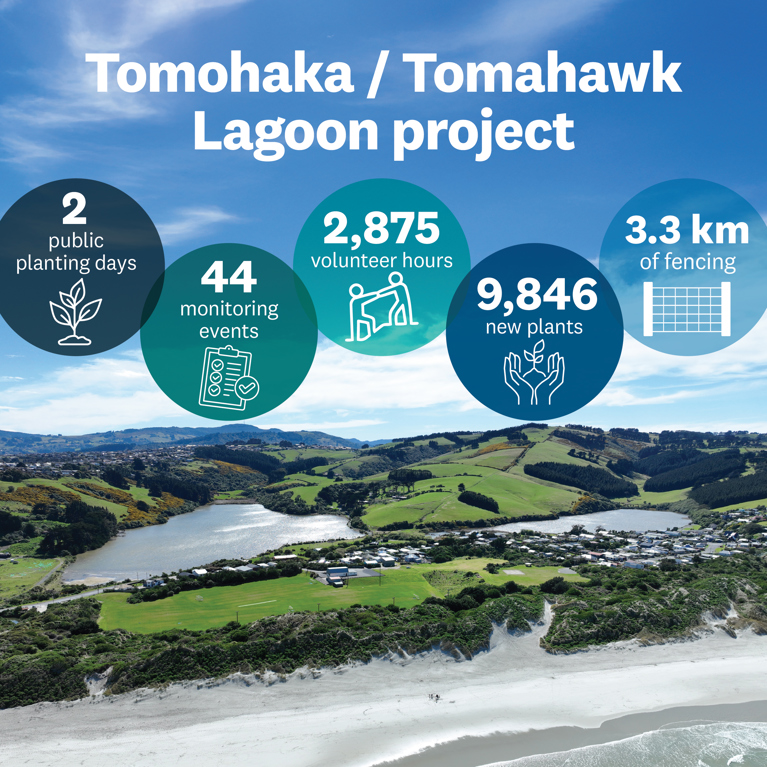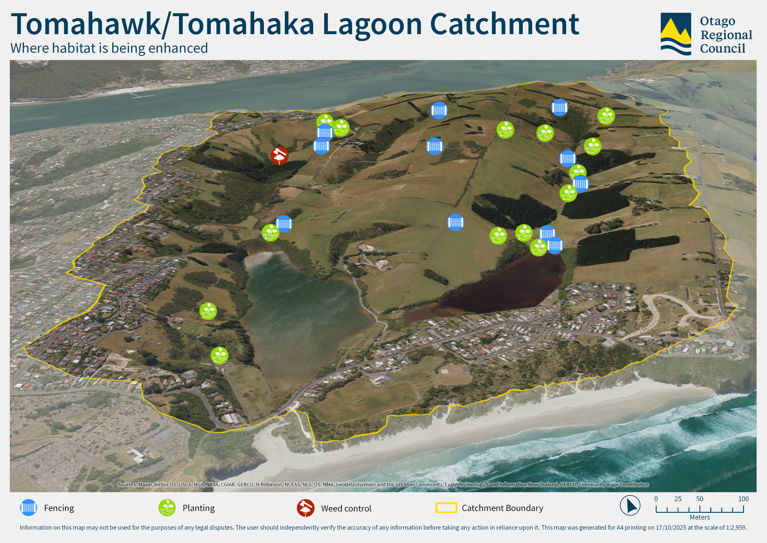-
-
-
-
-
-
-
-
-
Tomahaka Tomahawk Project Report
-
-
-
-
-
-
a-pied-stilt-or-white-headed-stilt-himantopus-leucocephalus-is-bending-over-and-looking-between-its-long-legs-at-tomahawk-lagoon-in-dunedin-new-zealand
a-pied-stilt-or-white-headed-stilt-himantopus-leucocephalus-is-moving-in-the-strong-wind-at-tomahawk-lagoon




July 2025
Long-term plan Level of Service: Partner with iwi and collaborate with communities and landowners to develop and implement projects which enhance water quality and indigenous biodiversity in selected degraded water bodies.
Short-term Outcomes
0–6 months
-
A collaborative effort has confirmed the Implementation Plan and timeframes
-
Increased engagement with landowners and community around enhancing water quality values in the Tomahawk Lagoon catchment
-
Areas for habitat enhancement are identified and plans are produced
Medium-term outcomes
6–18 months
-
Habitat is enhanced through planting and fencing
-
Opportunities to support community education are explored
ORC, partners and key stakeholders worked collaboratively to finalise an Implementation Plan based on the Ecological Assessment. The vision is “a thriving Tomahawk Lagoon catchment, where water quality and biodiversity are enhanced through community action to contribute to a healthy ecosystem for all to enjoy”. Activities focus on reducing contaminants entering the lagoons. The main change between the draft and the final was removing the activity ‘Construct a wetland at the outlet of Lagoon Creek’ and redirecting $30,000 of funding to ‘fencing and planting’.
The project has increased engagement with landowners and the community. Habitat enhancement site prioritisation and funding criteria were developed, and the funding was socialised with the community by letter drops and door knocking, resulting in:
- 8 landowners and 1 community group supported with funding and advice
- another landowner working directly with Otago Girls High School with ORC support
- 7 of the landowners involved are new to the catchment project
- 15 habitat enhancement sites (map on page 3)
- $163,116 invested in habitat enhancement
Most planting will be completed by June 2026 with ongoing maintenance. An agreement with Tomahawk Smaills Beachcare ends June 2027 to allow for infill planting. Two public planting days have been held. Overall, the community will achieve:
| Fencing (km) | Number of plants | Plant pest control (ha) |
Habitat enhanced (ha) |
|---|---|---|---|
| 3.3 | 8,736 | 2.4 | 18.9 |
Now that habitat enhancement is underway, ORC will monitor and support landowners and community groups to ensure agreements are followed and best practice advice is available.

Long-term Outcomes
>18 months
-
Improved stream and lagoon water quality
-
Enhanced native aquatic and terrestrial biodiversity
The community is on it’s way to achieving the vision of the Implementation Plan. With new landowners on-board, and active existing community groups, there is an opportunity to bring the community together to build connections and aid succession.
Long-term outcomes are being monitored by Ecotago, and through ORC’s monthly water quality monitoring.
Sediment traps in Lagoon Creek have been identified as an option to further reduce contaminants entering the lagoon, and this will be investigated.
Long-term outcomes are also being supported by ORC’s by exploring the possibility of zoning the catchment as a nutrient-sensitive zone in the Otago Regional Council Land / Water Plan.
| Activity | Budget ($) |
|---|---|
| Exploring installing sediment traps along Lagoon Creek. | 7,380 |
| Collaborating with mana whenua, community, schools and Ecotago to install signage to increase engagement. | 9,000 |
| Bring landowners and community together to share best practice, build connections and aid succession. | 300 |
| Funding for planting for a specific high priority site. | 13,320 |
| Total | 30,000 |

Tomahawk Lagoon sits at the southern end of the Otago Peninsula and is made up of two shallow brackish lagoons connected by a narrow channel and a weir, with a shared outlet to the sea.
It is a wildlife refuge of 33 hectares managed by the Department of Conservation and home to the threatened plant species Isolepis basilaris. The area is ecologically important as it is defined as a marsh - less than 15% of Otago’s original marshes remain.
The lagoon is a key wetland for waterfowl, waders, and migratory birds, and also provides habitat for native fish and eels.
Citizen Science results indicate that turbidity, E. coli, nitrates and phosphate levels are all exceeding national guidelines. Cyanobacteria, which can be harmful to people and animals, often appears in summer.
In 2017, ORC began working with the local community to address water quality concerns at Tomahawk Lagoon.
We’ve committed $260,000 over three years (2022–2025) to support catchment restoration through community-led action. In 2018, two workshops were held with the community to identify community goals and values, and potential projects for the catchment. In 2021, consultation with the community, mana whenua, and key stakeholders helped prioritise actions to be implemented for the catchment, with the top three outlined in the Tomahawk Lagoon Management Plan.
In 2022, ORC set up a monitoring site (named: Tomahawk Lagoon – Tomahawk Mid) at the deepest point of the upper lagoon as part of our State of the Environment programme. Water quality (nutrients, chlorophyll-a, bacteria, clarity) and physical parameters like temperature, pH, dissolved oxygen, and conductivity are sampled on a monthly basis.
In 2023, an Ecological Assessment of Tomahawk Lagoon was completed by Cawthron Institute, to do a study into ecological health and processes that control water quality at the lagoon. It provides an understanding of restoration options that could be employed to improve water quality and safeguard the ecological health of the catchment. The final report delivered on 31 July 2023 was shared with mana whenua, community representatives, and key stakeholders with the below recommended actions focus on reducing contaminants:
- Consider zoning the catchment as a nutrient-sensitive area in ORC’s Land and Water Plan
- Fencing and riparian planting, plus forestry buffers
- Enhancing existing wetlands




